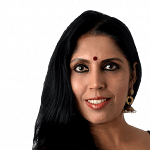Leading Indian contemporary artist Hema Upadhyay's murder has sent shock waves through India and the art world.
The 43-year-old's body was found together with that of her 65-year-old lawyer's in cardboard boxes in a mucky stream in Mumbai on Sunday. A probe is currently underway into the brutal double murder. The artist's hands were tied behind her back, covered in plastic and her body stuffed into the box.
Upadhyay had exhibited several times in Singapore, including at the premier fair Art Stage Singapore in January, and had a residency and solo show at the print institute STPI in 2008.
Tributes have been pouring in for the artist whose life was tragically cut short.
A graduate of India's Maharaja Sayaji Rao University, known internationally for its fine arts faculty, she shot to fame in 2001 when she unveiled an installation of 2,000 life-like acrylic cockroaches at the 10th International Triennale in New Delhi. Many viewers ran for cover. Some said they saw cockroaches in other parts of the space, some swore they saw them move, some walked out and others were quite simply shocked.
She won an award for the installation at the Triennale - she said it was inspired by the military standoff in Kashmir that year which threatened to escalate into a nuclear conflict - and got her first international solo exhibition in the same year at the Institute of Modern Art, Brisbane.
In 2008, she brought her roaches to Singapore for her first solo show here at the now-defunct Bodhi Gallery in Unity Street. Around the same time, she embarked on her residency at STPI.
STPI director Emi Eu tells The Straits Times that back then "she (Upadhyay) was becoming to be known as an artist in her own right".
"I found her works to be very challenging. They looked pretty but her subject matter was very strong. It was about pain, about turmoil and about mortality. She had such a sweet disposition and was always very welcoming. The news is just shocking," says Ms Eu.
The artist's 2008 STPI solo, titled Universe Revolves On, featured deeply personal print works that questioned the meaning of home in the face of India's rapid urbanisation. She incorporated sculptural wood formations in the paper works. Like much of her art that was to follow, the densely composed print work offered a commentary on how Mumbai's unstoppable growth left migrants like her feeling conflicted, isolated and displaced. She was an outsider who had moved from Vadodara in Gujarat to Mumbai in the late 1990s.
In an interview with The Straits Times then, Upadhyay said: "The feeling of being a migrant in a big city drew me to the stories of migrants here; their struggles, the fear of rejection which throws many of them into the grind of sweatshops. I want to continue exploring these struggles through my art."
Prominent regional art consultant and former gallerist Valentine Willie recalls meeting her during her STPI residency, describing her works as "very complex" and "genius".
He adds: "Any death is a loss, more so when it is someone such as Hema who was so talented and young with a bright future ahead of what would surely have been a stellar artistic career. It is heartbreaking just to think about it."
From the late 2000s, Upadhyay continued using elements of photography, painting and sculpture in mixed media pieces in which figures sometimes moved between stillness and agony, forming an uneasy link between the woman as a subject and an object.
Her art kept getting edgier despite her personal turmoil, or perhaps because of it. In 2010, she was locked in a bitter divorce case with her husband Chintan Upadhyay, also a leading artist. He has been questioned by the police regarding her death.
From roaches to dinosaurs to birds, new forms starting appearing in her art. The use of birds could be said to symbolise, on some level, her own pining for freedom, for flight.
At the 2016 Kochi-Muziris Biennale in Kochi, she presented a stunning and deeply meditative six-panel series ironically titled Silence And Its Reflections. Made of long grain rice arranged in waves with phrases handwritten on miniscule grains that could only be read with the aid of magnifying glasses, it unravelled like the undulating surface of an ocean. The patient viewer was rewarded with miniscule fragments of text that had been painstakingly handwritten on the rice grains.
Mumbai-based artist and former artistic director of the Kochi-Muziris Biennale Jitish Kallat calls her "untimely death deeply devastating; a chilling end to a life spent in artistic pursuit. The fact that she is no more with us is hardly sinking in."
Karachi-based artist and art educator Sohail Zuberi, who met Upadhyay in 2003 when she was in Karachi on a residency, said he had kept up with her artistic career all through these years. "She was at the prime of her life and I find it extremely hard to reconcile to the fact that she is gone. I keep telling myself that Hema lives on through her work, and she must."
Singapore-based ceramic artist Madhvi Subrahmanian who knew Upadhyay both personally and professionally, says she is "totally devastated" by the news of her death.
"The art world has lost such a bright spark. She was not only an outstanding artist but a kind and generous soul - she will be missed by many for a long time to come."






